How to get new equipment
Please note that products and brands mentioned are from suggestions by people with arthritis. We do not receive money or sponsorship by featuring them.
There are similar products produced by other brands, and we’d suggest looking around to see what’s available.
If you’re able to, ask for advice from an occupational therapist and try out any products before you buy. We cannot be held liable if any product featured in our content is unsuitable for you.
Local authorities
You may be able to get gadgets and equipment from your local authority.
Your local council may call equipment or modifications to your home ‘aids and adaptations’ or ‘community equipment’.
An aid is any equipment that can help you manage your everyday tasks. This could be:
- an easy-to-use electric can opener
- a mattress topper to help you sleep
- kettle tippers that make it easier to pour water.
Adaptations are physical changes, or home modifications, that can be made to help you get around your home. This could include:
- grab rails
- a level access shower
- a ramp
- a stairlift.
Local authorities have a duty to care for the people who live in their area. They should be able to tell you which types of care you are eligible for, and whether you will have to pay for this care or not.
Your local authority may also be able to arrange for you to have support in the home and advise you on local schemes and services that can help.
Help for equipment in England
In England, local authorities have to provide aids and home adaptations, up to the value of £1,000, to anyone who can’t perform two acts of daily living, like eating, washing or going to the toilet.
If there are things you struggle to do at home and this impacts on your quality of life, ask your local council for a free needs assessment. Everybody is entitled to one, and you could be eligible for free equipment.
You can find your local authority’s home adaptations service by entering your postcode at this website: https://www.gov.uk/apply-home-equipment-for-disabled.
Help for equipment in devolved nations
For information on the support available for aids and adaptations in Scotland, Wales or Northern Ireland visit the following websites:
- Northern Ireland: https://www.nidirect.gov.uk/articles/equipment-use-about-home
- Wales: https://www.gov.uk/apply-home-equipment-for-disabled
- Scotland: https://www.gov.scot/policies/independent-living/housing-adaptations/
Disabled Facilities Grants (DFG)
If you need to make adaptations to your home, you may be able to access financial assistance from your local authority. The Disabled Facilities Grant is designed to help people living with disabilities to meet the cost of making major adaptations to their home.
Eligibility for a Disabled Facilities Grant differs from eligibility for aids and adaptations in two important ways:
- The legal definition of ‘disability’ is different.
- The DFG is means tested, whereas eligibility for community equipment isn’t.
If you live in England or Wales you can apply for a disabled facilities grant with your local authority by entering your postcode at this website: https://www.gov.uk/apply-disabled-facilities-grant
If you live in Northern Ireland you should contact your local Health and Social Services Trust. You can find out more on this website: https://www.nidirect.gov.uk/articles/disabled-facilities-grants-0
Disabled facilities grants aren’t available in Scotland.
Make sure you apply for the grant before you start any work on your home, or your application could be rejected.
To find out more about disabled facilities grants see our factsheet Know your rights: Disabled Facilities Grants (PDF, 105 KB).
Getting advice from a professional
It’s a good idea to speak to an occupational therapist about your daily needs and the equipment available. You can ask your doctor to refer you to one or you can refer yourself.
An occupational therapist will be able to give you advice on the best equipment available. They can also give you tips on ways of pacing yourself and changing the way you do tasks to make them easier.
Their advice should help you manage fatigue, reduce your pain and can help you keep your independence.
New gadgets can make daily tasks easier on your joints. But stopping regular movements, no matter how small, could create stiffness and loss of movement. So, make sure you’re still exercising your joints in other ways to keep them strong and mobile.
For more information on staying active visit our exercise pages.
Purchasing new equipment
If you’re not eligible for support, or prefer to purchase your own products, you’ll be able to get many of the gadgets mentioned here online, as well as in supermarkets and local hardware stores.
Make sure you compare prices at a few different places before you buy anything. Where possible, try out the equipment before buying it, to make sure that it’s right for you. If you can’t do this in store, you can try out items and get expert advice at demonstration centres. These can be found in Disabled Living Centres, social services centres, and occupational therapy departments. Visit Living Made Easy for information on your nearest centre.
Most of the staff at Disabled Living Centres are occupational therapists or physiotherapists, who can give impartial advice. It can be a good idea to go with a friend or relative to help you decide on the best equipment for your needs.
AskSARA
AskSARA gives helpful advice on gadgets and equipment to make everyday activities easier. The website will ask you to select the topic you’re interested in and answer a few questions before giving a personalised report full of useful advice and products that may help you.
Other organisations that can help
There are many organisations and charities that will be able to offer advice and support for people wanting to get started with new equipment.
The British Red Cross runs an equipment loan service for wheelchairs and other specialist equipment, and Age UK helps with shopping and housework in some areas.
Age UK also offers handyperson services for help with gardening and small household jobs, such as changing the batteries on smoke alarms. Alternatively, your local authority is likely to be able to recommend a reliable handyperson service.
There are also charities and organisations that can adapt existing items in your home or even create new equipment tailored to your specific needs. While many places may charge a fee, there are charities which provide their services for free. Have a look at a charity called Remap, who provide custom made equipment for people with disabilities. Their services are also completely free.
Home improvement agencies are local not-for-profit organisations that can help people adapt their homes. You can use the findmyhia.org.uk webpage to find a home improvement agency in your area.
Your local fire service is likely to offer free safety checks for your home. They can test, fit and relocate smoke alarms as well as provide new batteries – all free of charge. They can also help you work out an escape route and will check for any potential trip and fire hazards.
These and other voluntary organisations which can help are listed in the ‘Related organisations’ section of this webpage. You may also find others online or in your phonebook. You can also ask your local authority, Social Services department or the Citizens Advice Bureau.
Tips for every room around the house
Reducing bending
- Attach a basket to the inside of your letterbox.
- Move electrical sockets higher up the wall with an extension cable or by getting them rewired.
- Try using a reaching stick or pick-up stick. These can also be useful to remove clothes from inside the washing machine.
- Use a laundry basket that has a handle and wheels.
- Raise your washing-up bowl by putting it on blocks or another upturned bowl in the sink.
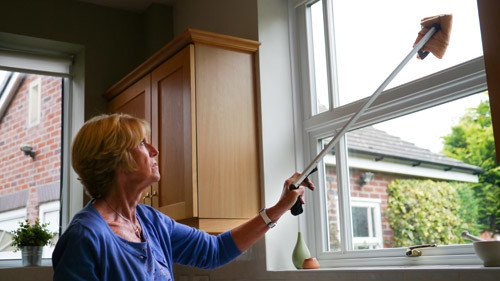
Reaching stick.
Housework and DIY
- Use a towelling mitt for dusting or cleaning mirrors and windows, as it’s easier than gripping a cloth.
- Use a long-handled dustpan and brush.
- Choose a lightweight ironing board that is easy to open and close. You could also think about installing a wall-mounted ironing board.
- Tabletop ironing pads can be handy for smaller items and saves getting an ironing board out.
- Pad the handles of tools to make them easier to grip and buy lightweight, power-assisted tools, such as drills or screwdrivers.
Making switches, plugs and keys easy to use
- Large rocker, pull-cord or touch-operated light switches are easier to use.
- Electric or gas fires are easier to turn on if the control knob is located at the top. Or consider getting a model that uses a remote control.
- You can buy specially designed grips to help you turn dials and knobs, and make plugs easier to pull out.
- Key turners can help with inserting and turning the key in the lock.
- Wrapping an elastic band around rounded door handles can make them easier to open.
Avoiding trips and falls
- Remove any loose mats or carpets.
- Make sure your stairs, hall and landing are well lit.
- Make sure you have enough space to get between or around your furniture.
- Fix a grab rail by the front door to help you go in and out.
- Think about altering your doorstep, especially if mobility is a problem or if you use a walking aid or wheelchair.
Medication management
- If you have trouble opening childproof containers, your pharmacist might be able to put them in a more suitable container for you.
- Pill removing gadgets are available if you struggle to get your pills out of the packet.
- You might find it handy to organise your pills in a box containing separate compartments for every day of the week.
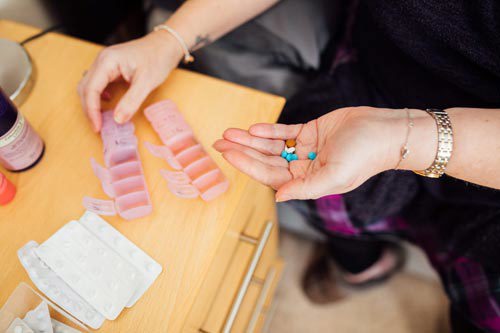
Pill organiser.
Technology and leisure activities
Using phones and tablets
- Many smart phones and tablets can be used with a stylus to make it easier to type.
- Smart phones now have voice activated features which include message dictation, web searches and hands-free phone calls.
- Try to get a cover that makes your phone or tablet easier to hold. Many covers also double up as stands.
- Gadgets, such as a PopSocket, can make it easier for you to hold your smartphone.
- Think about purchasing touchscreen gloves to use your phone more comfortably when outdoors during the colder months.
Personal alarm system
A personal alarm system is a device that can call for help if you fall or have an accident at home. They can be kept in a pocket, pinned to your clothes or even worn around the neck or wrist.
Many councils and charities, including Age UK, operate a phone-alarm system for a small fee.
Smart speakers
Smart speakers, such as Amazon’s Alexa devices, Google Home or the Apple HomePod, can be used to make your home much more accessible. They can play music hands-free, as well as control your lighting and other devices in your home. You can even use them to make phone calls without using your phone.
Some speakers can also function as a personal alarm system - you can ask the speaker to alert someone if you have an accident and can’t make it to the phone.
Using a computer
Voice activated software can be a good alternative to typing on a keyboard. You could try downloading a free version of the software before deciding if you need to pay more for a professional version.
Try resting your wrists on a sponge bar in front of the keyboard – mouse mats are available with similar cushioning if you feel you need the extra support. Ergonomic mice are available which can be held vertically. Some also have trackballs instead of scroll wheels, which can be easier to use.
Have a look at our working with arthritis page for more information on changing your workstation and getting support at work.
Reading and writing
- Look for a pen that has a chunky grip which is easy to hold.
- Try resting your book or newspaper on your lap or on a table to avoid straining your fingers.
- Rest a book on a beanbag, lap tray or book rest.
- Think about using an e-reader or tablet to get digital copies of books and magazines, as these may be easier to hold than a book. You can also get covers that double as stands so you don’t have to hold them.
The kitchen
Top tips for the kitchen
- Use lightweight crockery and cups with large handles that can be gripped with several fingers.
- Insulated or pedestal mugs can be held with both hands, because you can support them underneath without burning yourself.
- A trolley could be useful for moving heavy plates of food.
- Most supermarkets sell pre-prepared food, such as chopped vegetables and grated cheese.
- Frozen vegetables will save on preparation and often have a similar nutritional value to fresh vegetables.
- Having some pre-prepared ingredients or ready-made meals in the freezer can be handy when your arthritis flares.
- Consider purchasing a washing-up bowl with a drainer in, so that you can empty the bowl of liquid without having to lift it.
Gadgets for preparing food
- Kettle tippers – you can even bring water to the kettle in a lightweight plastic jug to avoid having to move it.
- Hot water dispensers are a good alternative to using a kettle, but you’ll still need to fill it up using a plastic jug.
- Hand-held electric blenders.
- Easy-grip cutlery with chunky handles.
- You can also try a Mezzaluna knife – which is a curved blade with a handle on each end. It’s most commonly used to chop herbs, but you can also use it to chop meats or cheeses.
- Non-slip mats.
- Wide handled potato peelers.
- A food processor for chopping, grating and mixing.
- Ring pull or electric can openers.
- Easy-grip bottle openers and jar openers.
- Spring-loaded scissors that open by themselves are good for packets.
- OXO Good Grips produce a wide range of non-slip and comfortable kitchen equipment.
You could also try:
- making a wooden spoon, knife and other handles bigger by adding some foam tubing
- wrapping an elastic band or a tea towel around tight bottles or jars, to help pry them open
- placing a cloth under a bowl, so that it doesn’t slide around if you want to use both hands to mix
- making individual drinks in the microwave.
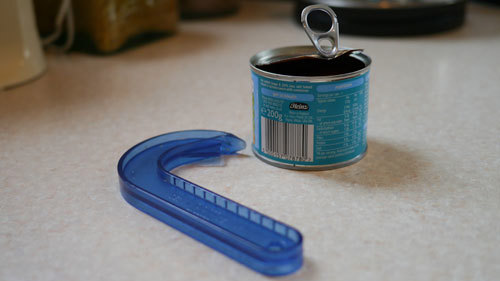
Ring pull tin opener.
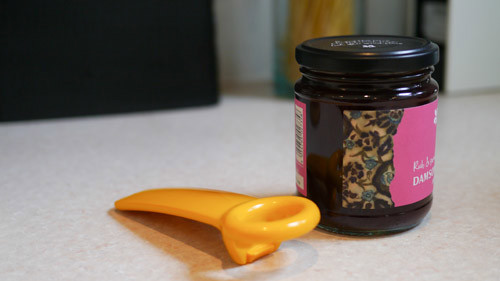
Jar opener to help release the vacuum sealing the jar.
Cooking tips
- Use a lightweight saucepan with two handles.
- Use a vegetable steamer – they can be lighter than a saucepan because less water is needed.
- A tabletop slow cooker can be easier to use than a casserole dish that you place in the oven.
- Use a slotted spoon to remove boiled vegetables from the saucepan.
- Use a ladle to remove soups and stews from the saucepan.
- Use a wire chip basket, placed in the saucepan first, to lift out vegetables when cooked.
Work surfaces and cupboards
Reaching into very low or high cupboards can be hard, particularly if they’re cluttered or stacked several layers deep.
The following tips might help:
- store items you use often within easy reach
- use plate racks, rather than piling crockery up
- use step-shelves inside cupboards, so that you can easily see and reach jars and tins.
Buying new kitchen equipment and appliances
When buying new equipment for your kitchen, ask yourself the following:
- Are control knobs easy to reach, grip and turn, push or pull?
- Is the appliance easy to use?
- Will you be able to clean and maintain it easily?
- Can you lift and move it if you need to?
Tips for redesigning your kitchen
- Have wall-mounted cupboards moved to a lower position.
- Fit large handles or sliding doors.
- Have drawers mounted on rollers, which run more easily than standard drawers.
- Have shelves that slide or rotate out when you open the door.
- Make sure all the cupboards and surfaces are at the right height.
- Have a wall mounted oven with a drop-down door to make it easier to reach in and remove items.
Top tips for food shopping
- Online shopping is a really convenient way to get food. Most supermarkets offer a free click and collect service, but you can also get your shopping delivered to your door for a small fee.
- Plan to shop on a day when you don’t have many other things to do.
- Don’t try to carry too much in one go.
- Use shopping bags with strong handles, which are easier to carry – you should be able to buy these at supermarkets.
- Adapted silicone bag handle grips stop carrier bags digging into your fingers.
- Ask for help at the supermarket, especially with packing and loading into the car.
- Consider using a shopping backpack, or a trolley on wheels for short trips on foot.
- Ask friends or neighbours to shop for you.
Many large stores provide wheelchairs for customers. Some councils run Shopmobility schemes, where you can hire wheelchairs and scooters to go shopping or around town.
Visit the government’s webpage on community transport services and Shopmobility to find out what services are available in your area.
The bathroom
Top tips for the bathroom
- Liquid soap in a push-down pump bottle is easier than using a bar of soap.
- You can also try refilling a suitable pump bottle with your favourite shampoo, conditioner or face cleanser.
- Try fattening the grip of a toothbrush by wrapping an elastic band around it.
- A thick towelling dressing gown is much easier than struggling to dry yourself with a bath towel.
- You may find using a microfibre towel helpful, as they’re much lighter than normal towels and you don’t have to rub yourself. They can be found in outdoor pursuit shops.
- Use a lightweight electric razor.
- Use an electric toothbrush.
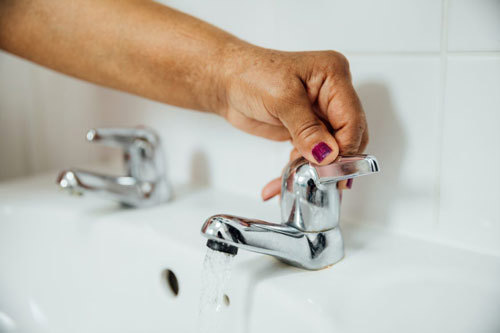
Lever taps.
Gadgets and aids for the bathroom
- Lever taps are easier to use than regular taps. You can buy these, or fit tap turners on to existing taps.
- You can get long-handled versions of most equipment, including long-handled sponges, hairbrushes, combs and toe wipes.
- A long flannel strap with rings at either end can be great for drying those hard to reach places.
- A toothpaste squeezer might help.
Getting in and out of the bath
If you find getting in and out of a bath difficult, think about getting some of the following:
- a grab rail
- a non-slip mat
- a bath board and seat
- a powered bath seat lift
- a walk-in bath – although these can be very expensive.
Before you buy a new walk-in bath or a powered bath seat it’s worth speaking to an occupational therapist to ensure you get a suitable model for your needs.
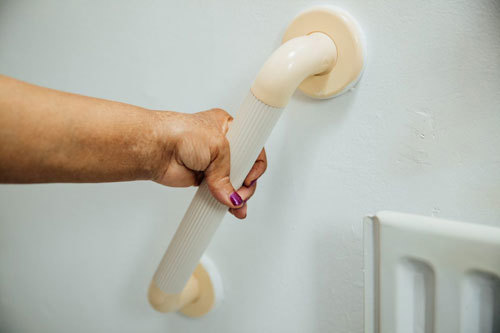
Grab rail.
Taking a shower
- A grab rail and fold-down wall seat, shower stool or even a plastic garden chair placed in the shower will help you shower more comfortably.
- Large, easy access walk-in showers are often cheaper to install than a walk-in bath.
- Some people even redesign their bathrooms to make a large wet room. However, this can be expensive.
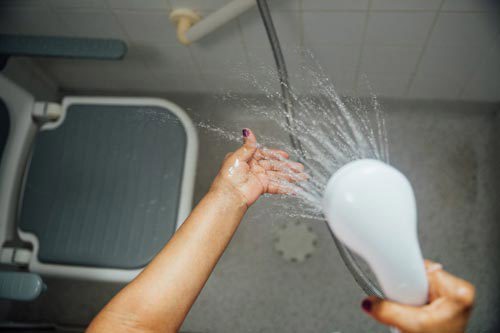
Fold down shower seat.
Using the toilet
Equipment that can help includes:
- a grab rail beside the toilet
- a raised toilet seat
- a toilet frame
- a bottom-wiping gadget
- a portable bidet which fits onto a standard toilet pan
- an automatic flushing toilet with built-in bidet, which washes and dries you
- gadgets that convert toilets into automatic flushing toilets.
Periods
Inserting and removing tampons or menstrual cups might not be easy, especially during a flare. But there are alternatives that should be easier to use.
A number of different companies have now designed easy to use menstrual cups to make them as easy to use as tampons. So have a look around and see if there are any which might be suitable for your needs.
Period proof underwear can also be a good option if you want to avoid menstrual cups, but still want something that’s reusable.
The bedroom
The bed
Making a bed can be difficult. A common problem is shifting the weight of the mattress. This can make tucking in bedclothes painful and difficult. You may find it helpful to have a lightweight mattress or to use a mattress pad on top of your ordinary mattress. This means you only need to lift a thin pad to tuck sheets under. Try using fitted sheets and a duvet.
Using an extra sheet under the duvet will mean you don’t have to change the duvet cover as often. Some duvet covers come with bigger buttons, rather than small poppers at the base.
You could also try using easy grip pegs to hold the duvet in place on the bed, to make it easier to pull the cover on. Use the pegs to hold the top of the duvet and duvet cover together so that you can shake the rest of the duvet into shape.
The mattress
The perfect mattress should provide the right balance between comfort and support for your spine. There isn’t a ‘one size fits all’ approach – while some people might prefer a hard mattress, softer ones can be just as good. It all depends on your personal preference and your condition.
A mattress has a set lifespan, and when that’s over, it will sag. If you can feel the springs easily or if it’s lumpy, saggy, or floppy, it’s probably time to replace it.
You may be advised to put a board under a sagging mattress. This is poor advice and won’t improve how it works. In fact, a board under the mattress can actually create painful conditions at the pressure points of the hip and shoulder.
Before you buy a new mattress, do your research. Go to a good retailer who can discuss the features and benefits of their products.
Don’t be shy about trying out several beds in the store, particularly in the position you sleep in. If you share a bed with someone, take them along too, so you can find a mattress that suits both of your needs. And take your time – physiotherapists recommend trying a mattress for 20 minutes before buying.
Many people find memory foam mattresses or toppers helpful. A common recommendation is to buy a firm or orthopaedic mattress. But whether this is right for you depends on many factors, including:
- your weight and build
- your size and age
- the way you sleep
- the sort of aches and pains you have.
Pillows
Choosing a comfortable pillow can help reduce neck and shoulder pain. Shaped or memory foam pillows can also be useful.
There’s no specific type or number of pillows that will suit everybody. What’s best for you will depend on how you sleep and what you find most comfortable.
The best thing you can do is find a position in which your neck is aligned with your spine. Be careful not to prop your pillow too high, as this can put your neck at an uncomfortable angle.
A pillow placed between your legs when lying on your side can provide extra support if you have any hip or knee pain. Some people find long body pillows to be particularly comfy. There are also specialist pillows available, which are moulded to the shape of your legs and can provide more support than an ordinary pillow.
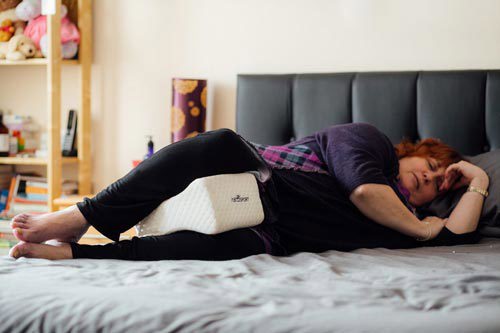
Memory foam knee pillow.
Dressing
It’s usually easiest to sit down while putting your clothes on, and there are a wide variety of gadgets to help, including:
- a buttonhook for fastening buttons
- long-handled shoehorns
- a dressing stick
- sock or tight aids to help you pull them onto your feet and up over your legs
- a front fastening bra can be easier to manage. Bras without fastenings that you pull on over your head or pull up from the floor are also available.
You can adapt clothes by replacing some fastenings with Velcro. Try placing a zip pull tag, small piece of ribbon or key ring on a zip to hook your finger through.
Some companies will be able to fit shirts and blouses with magnetic buttons. You might also want to have a look at The Able Label for clothes specially designed to make dressing easier.
For information on footwear and what you should look for in a good pair of shoes visit our footcare and footwear page.
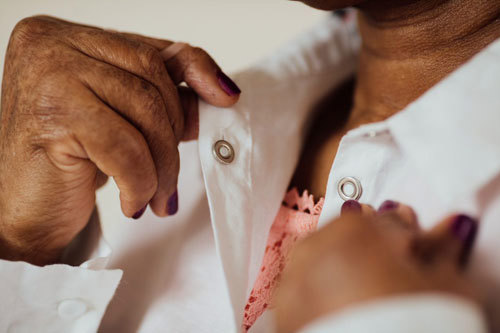
Shirt with magnetic buttons.
Getting ready
- Using a hairdryer or straighteners may be easier if you sit at a table and support your elbow on a pillow or cushion.
- Think about getting a hair dryer brush so that you can dry and style your hair with one hand.
- Try hands-free hairdryer holders or stands.
- Use a small make-up sponge to apply face cream if you find it difficult to do with your fingertips.
- Wrap elastic bands around makeup pencils or brushes to make them easier to grip.
Stairs
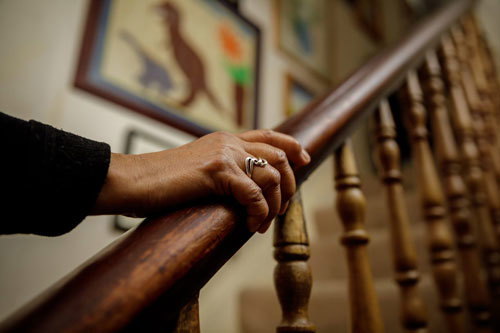
If you struggle to use your stairs there are a number of things you can do:
- If you have the space and the facilities to do so, you could rearrange your living space so that you only use the ground floor.
- Move to a bungalow or ground floor flat.
- Install adaptations, such as grabrails, an extra stair rail or stairlift.
Before you make a decision, make sure you get some professional advice from an occupational therapist about what your needs are and speak to your local council about the grants available.
Stair rails
There are quite a few options when it comes to stair rails. When installing them you should try to make sure each end extends to just past the bottom or top of the stairs, so that you have a steady anchor point to grab hold of.
Most staircases will already have handrails installed, but if it’s not long enough to provide an anchor point, you might want to consider extending them. Your local DIY store will likely sell handrails which can be used to extend the existing rail.
There are a wide variety of stair rails available for all shapes and sizes of stairs. You can get short grab rails installed over just a couple of stairs, and rails that are designed to bend around the upright post of the stair banister.
You may even want to think about installing stair rails that move with you. These rails have a bar that folds down that you can grab hold of and slide along the stair rail. They are designed to stop moving when a sudden movement is made, so they can hold you steady if you lose your balance.
If you need a trader to make any changes to your home, it’s a good idea to check if your local council runs a trusted trader scheme. They’ll help you find a reliable trader that will do a good job at a fair price.
For more information have a look at Living Made Easy's stair rail information.
Stairlifts
You can get stairlifts to fit pretty much every type of staircase. The shape of the track depends on the staircase, but ones with straight tracks are generally cheaper than curved tracks.
There are a wide range of designs to suit your needs. Some you can use standing or perching. Others have seats and some have wheelchair platforms.
Remember to try before you buy, as everyone’s needs are different. Here are some features to consider:
Seat height
Some chairs have adjustable seat heights. If you have any hip, knee or back problems, the height of the stairlift seat is important. You should make sure the seat height is right for you at both the top and bottom of the stairs.
Swivel seats
Swivel seats can be manual or automatic and are designed to make it safer to get on and off a stairlift. They work like an office chair and swivel at the top of the stairs, so you end up facing the landing. These seats also have armrests for you to grip, making them easier to get out of.
Control switches
When it comes to controlling the stairlift, you can choose between different types of controls, including joysticks or rocker switches. Depending on how arthritis is affecting your hands, you might prefer to use one design over another, so try them out and see what works best for you.
Hinged rails
If there’s a door that could be blocked by the track of the stairlift, you might want to consider installing a hinged rail that can be folded away. If you’re unable to fold it away manually there are motorised hinges available.
Foldable chairs
Some stairlifts make it difficult for others in the house to climb the stairs. In these cases, the footrest, seat and armrests need to be folded out of the way. You can select a design where the footplate and armrests automatically lift out of the way when the seat is folded up.
Although stairlifts with wheelchair platforms fold away, these types of stairlifts can take up a lot of room and often staircases aren’t wide enough for them. So, you might have to consider if a through floor lift would be a better option.
Safety
Stairlifts should have sensors that stop it from moving if they sense an object is in the way.
If you think you may have trouble with young children wanting to operate the lift, you can get models that can be turned off with a key.
Don’t take a walking aid with you on the stairlift. It might catch on the steps or banisters while the lift is moving. Ask for another walking aid so you can have one at the top of the stairs and one at the bottom. If you use a wheelchair you might need to think about having one upstairs and one downstairs.
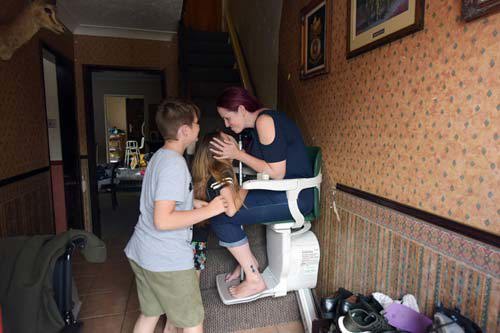
Through-floor lift
If there isn’t enough room on your stairs to install a stairlift, a through-floor lift is another option. It can be placed in a living room or hall and go up through the ceiling to a landing or bedroom.
However, you will need more space than you would for a stairlift, and you’ll have to make some structural changes to your home.
There are two types of through-floor lift:
- the standard lift that you see in most public buildings, which must be enclosed in a shaft
- vertical lifts without a shaft.
Vertical lifts without a shaft are a common option in homes, as they require fewer modifications to the rest of the house. They are most commonly used for wheelchairs, but standing and sitting versions are also available.
Short rise lifts
Another option, for smaller changes in elevation, is a short rise lift. These can be fixed in place or portable. Mobile ones are particularly handy if you don’t often need to access the other level, as you don’t need to make any structural changes to the rest of the building.
If you decide to get a portable one, you should check how easy it is to move the lift around your home.
Stairlift costs
Purchase
Stairlifts are usually cheaper than through floor lifts as they are easier to install and require fewer modifications to the house.
You may even be able to get a second-hand stairlift, but try to get it straight from the manufacturer or an authorised organisation to make sure it’s in good working condition, under warranty and suitable for your house.
Always get a few quotes from different suppliers so you can do a price comparison. But make sure you won’t be charged extra for the quotes.
Stairlifts typically range from £2,000 to £6,000, but can be more. The price will vary depending on the size and shape of the staircase, as well as the type of stairlift being installed. If your stairlift has a straight track, you’ll usually be able to sell it once you no longer need it. Selling curved tracks can be trickier.
Lifts are classified as a major adaptation. If you need financial help to afford one, you should apply for a Disabled Facilities Grant from your local council.
There are also charities and organisations that may be able to help. Turn2us is a charity that provides financial support. You can find out on their website what grants you could be eligible for.
Running costs
The cost of running a stairlift is very small. In fact, manufacturers claim that it’s cheaper than owning a kettle. Maintenance can be more expensive and varies from make to make. But it’s important that your stairlift is inspected at least once every six months and serviced every year.